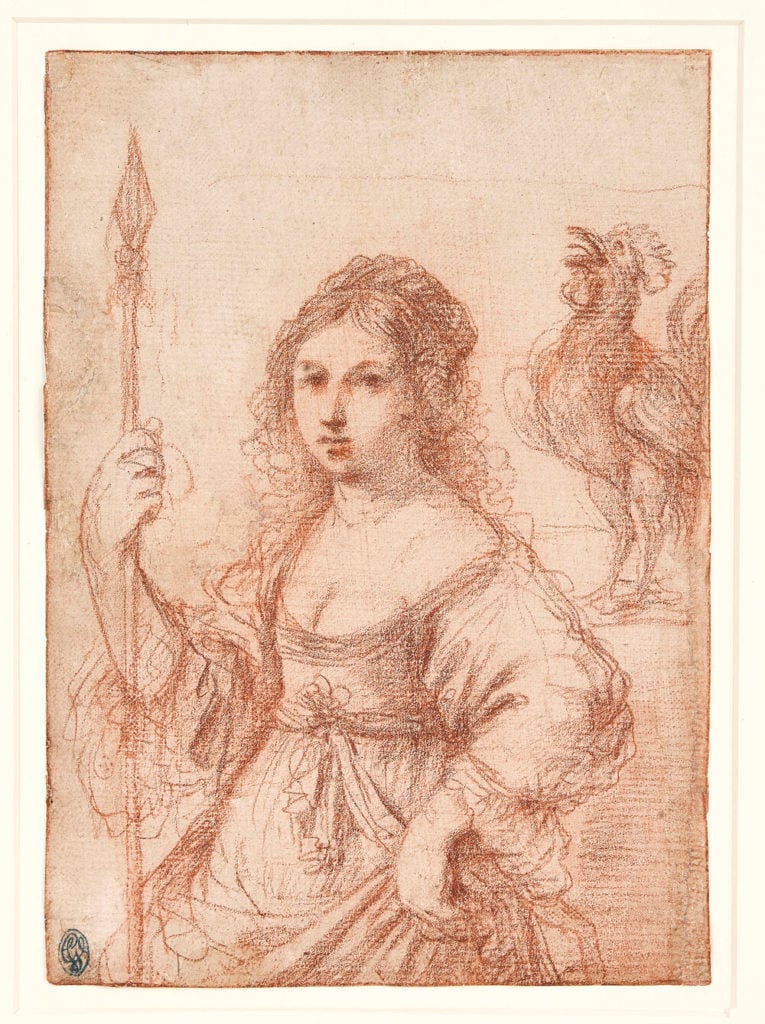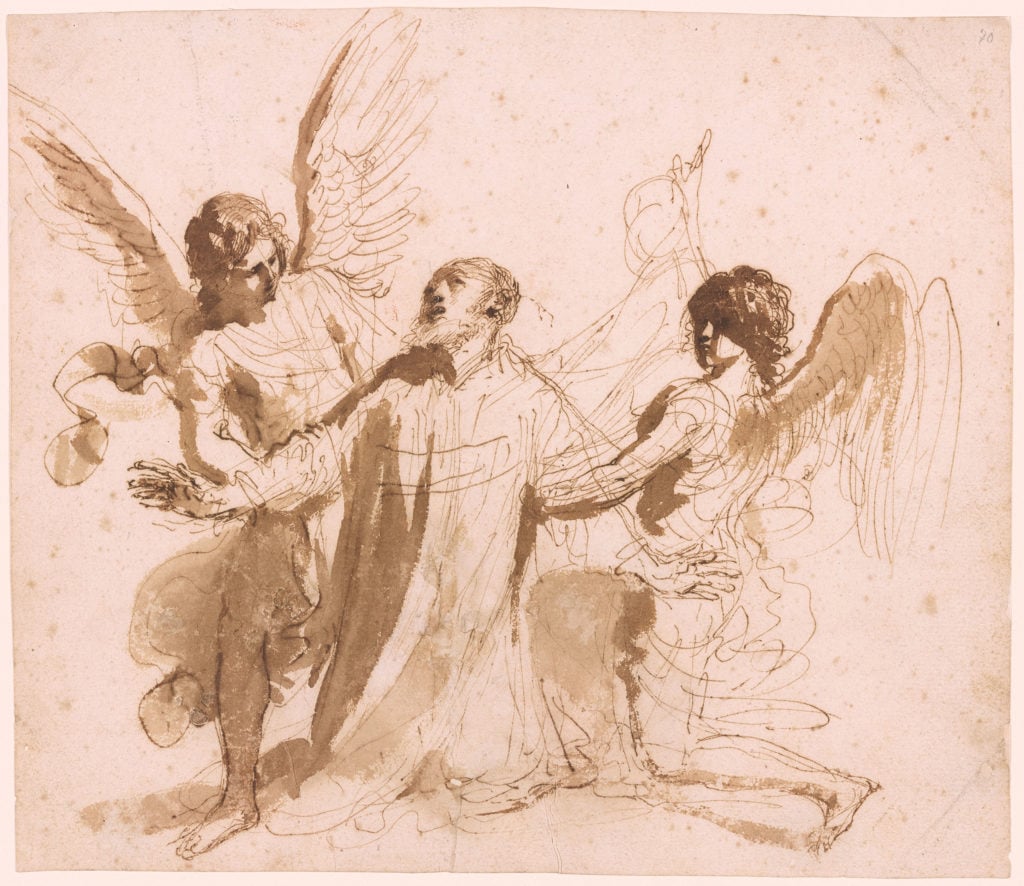Market
A Sharp-Eyed Dealer Bought a Mislabeled Guercino Painting for $74,500. It Could Be Worth $1 Million
The Italian Baroque master's work was misidentified as a 17th-century Dutch painting.

The Italian Baroque master's work was misidentified as a 17th-century Dutch painting.

Sarah Cascone

A newly rediscovered painting by the Italian Baroque painter Giovanni Francesco Barbieri, better known as il Guercino, is on view this week at New York’s Christopher Bishop Fine Arts as part of Master Drawings New York.
Remarkably, for the first time in some 300 years, the dealer has also managed to reunite the painting, Aurora (1662), with its preparatory drawing, which was in fact instrumental in definitively identifying the lost canvas.
The dealer purchased the painting, previously unknown to scholars, at Doyle New York in 2012. It was listed for sale as a 17th-century work from the Dutch School with a pre-sale estimate of just $2,000–4,000.
“It was obvious to me that it was misidentified,” Bishop told Artnet News. “I knew first of all that it couldn’t be Dutch, and I had an inkling that it might be Guercino.”
On the basis of that hunch, Bishop went to see the work in person. “I knew pretty much immediately what it was—there’s a certain masterful and unfinished aspect to the late work of Guercino that is unmistakable when you really know it,” he said.

Installation view of Guercino’s Aurora and its preparatory drawing at Christopher Bishop Fine Art. Photo courtesy of Christopher Bishop Fine Art, New York.
Other bidders seemed to have had a similar idea. The final selling price was $74,500—an astonishing 1,862 percent more than the high estimate. “A couple of other people must have figured out what I figured out!” said Bishop.
As an authenticated Guercino, the canvas is worth much more even still. According to the Artnet Price Database, the artist’s record at auction is £5.19 million ($7.86 million), achieved at Christie’s London in 2010 for the oil painting King David.
“The Guercinos that bring millions and millions are generally large-format multi-figure works,” said Bishop. “These single-figure works tend to bring from the mid six figures up $1.2, 1.4, 1.6 million, and that’s in line with what I’m asking for the piece.”
Bishop is hopeful that he can find an institutional buyer, preferably one who will take both the drawing and the painting. “The two pieces together are worth four times as much!” Bishop said. “You rarely see studies and paintings side by side. The survival rates for works on paper of this period are not fantastic, so there are lots of paintings for which we simply don’t have the preparatory drawings.”

Giovanni Francesco Barbieri, known as il Guercino, An Allegory of Vigilane. Photo courtesy of Christopher Bishop Fine Art, New York.
It was the drawing that helped Bishop really nail down the authentication question. The Aurora drawing sold last January at Sotheby’s New York under the title An Allegory of Vigilance, fetching $25,000. That work had remained with the artist’s family after his death, and its existence offered convincing proof of what Bishop had long suspected: the painting was by Guercino too.
“It’s really a story of scholarly patience,” said Bishop. “You need to have the instinct and the gut to understand what you’re looking at, but you also need a couple more pieces of the puzzle!”
After acquiring the drawing, Bishop revisited the research he had done after acquiring the painting in 2012. That had involved delving into Guercino’s account books, detailed records of every work painted and sold by the artist and the buyers.
“Artists’ records weren’t typically this well kept, but the business part of the enterprise was given over to the artist’s brother so that Guercino could focus on the painting aspect,” said Bishop. “The account book was preserved by the family and ended up in the state archive of Bologna.”
Although the painting’s artist had been misidentified, the frame still bore a 19th-century name plate with the title Aurora—the correct title, it so happened. The account book revealed that Aurora was commissioned by Capitano Raffaello Gabrielli, a Bolognese solider who collected several works by Guercino.
“The pieces of the puzzle started to fit,” said Bishop. “You don’t always get that deus ex machina moment where the drawing shows up and you know that you were right all along!”
For final confirmation, Bishop arranged a meeting with art historian Nicholas Turner, a Guercino expert and former curator of drawings at the J. Paul Getty Museum. Turner authenticated the painting as being by the hand of Guercino. (The timing was also fortuitous, with an exhibition of the artist’s work on view through February 2 at the Morgan Library & Museum.)

Giovanni Francesco Barbieri, called Il Guercino, Vision of St. Philip Neri (1646–47). Courtesy of the Morgan Library & Museum, gift of János Scholz.
The newly discovered composition depicts the goddess of dawn as a solider watching over the city of Bologna through the night (hence Sotheby’s alternate title An Allegory of Vigilance). For the original owner, Aurora would have had a special personal meaning.
“The virtues this women incarnates are the values of the Christian soldier and those would have been his values,” said Bishop. “Aurora represents the fierceness and the spirit of freedom of the Bolognese people, who were very proud not to be subjugated by Rome or Florence or Venice or Milan or any of the more powerful neighbors that surrounded them.”
So where was Aurora all these years? In a private American collection for some 60 years, according to Bishop. “The sellers knew very little about where it was acquired,” he said. “What’s remarkable is that Aurora retained the correct title. Sometimes there’s an inventory of the collection dictated by a parent to a child, and two labels get switched, or someone misremembers which one grandpa was talking about when he was talking about a Dutch painting—it’s kind of like a game of telephone.”
“Guercino’s Aurora Rediscovered” is on view at Christopher Bishop Fine Art, 1046 Madison Avenue, New York, January 24–February 15, 2020.
“Guercino: Virtuoso Draftsman” is on view at the Morgan Library, 225 Madison Avenue, New York, October 4–February 2, 2020.